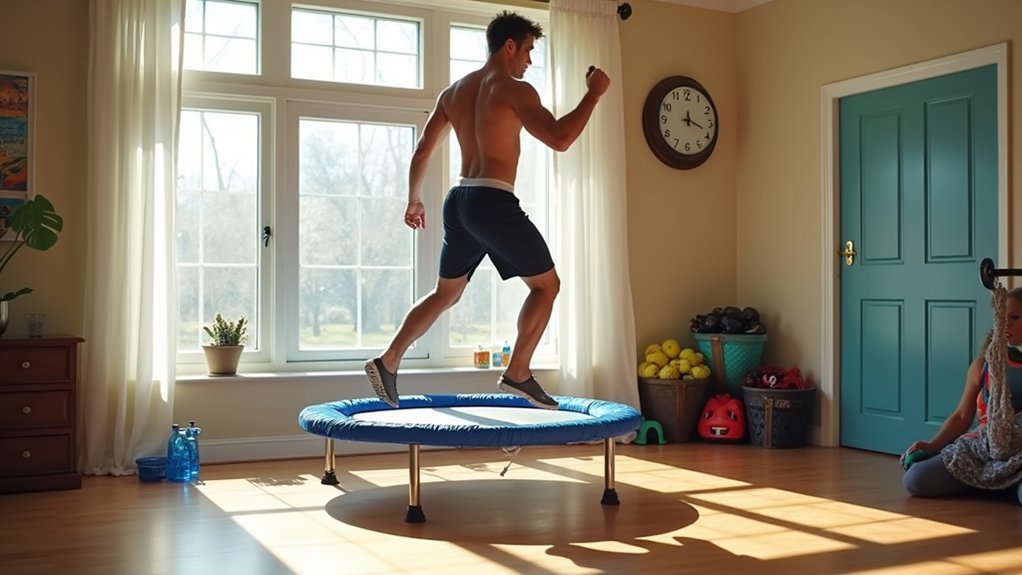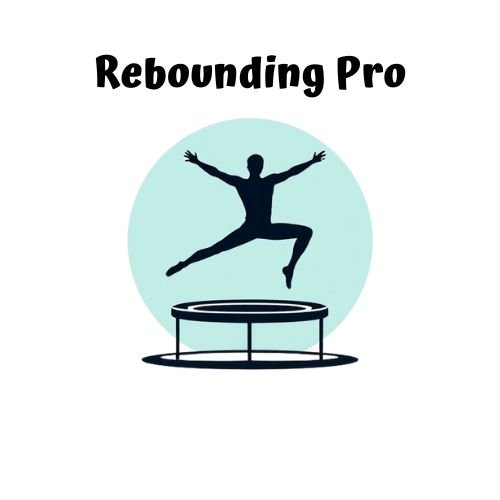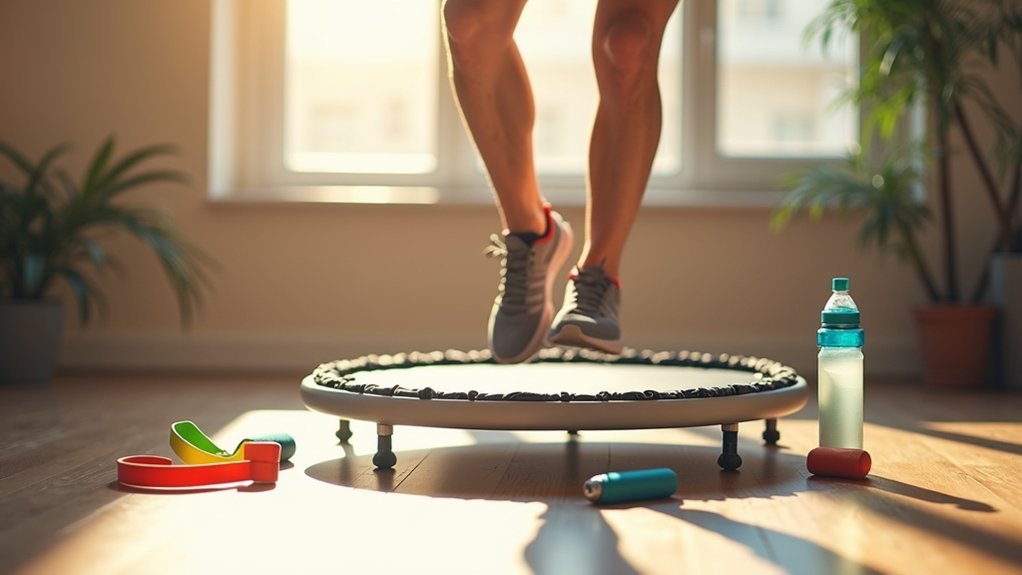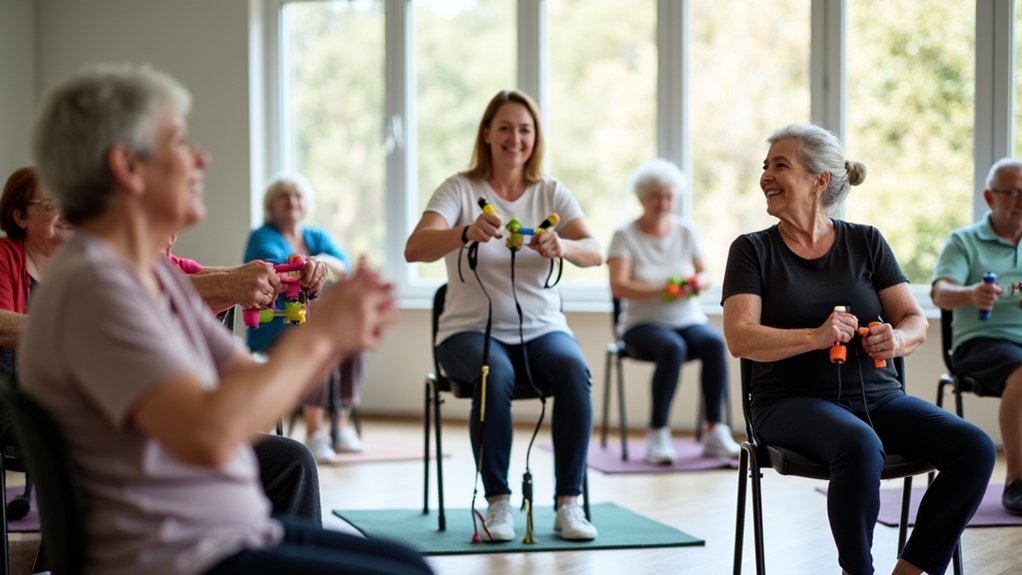To maximize calorie burn on your rebounder, incorporate HIIT protocols like Tabata (20 seconds intense work, 10 seconds rest) for metabolic boost. Combine movements that engage multiple muscle groups simultaneously—try adding arm raises to jump squats or twists during bounces. Schedule consistent 10-30 minute sessions with varying intensities throughout the week to optimize the afterburn effect. The science behind these techniques reveals why rebounding can outperform traditional cardio for fat loss.
Master High-Intensity Interval Rebounding Techniques

High-intensity interval training on a rebounder transforms your typical bouncing session into a calorie-torching powerhouse. Alternate between 10-30 second max-effort bursts (think high knees or tuck jumps) and 10-60 second active recovery periods to optimize fat burning.
Structure your workouts using proven protocols like Tabata (20 seconds on/10 seconds off) or EMOM (every minute on the minute) formats. Incorporate directional changes and multi-plane motions to engage stabilizer muscles and elevate your heart rate further. The trampoline’s rebounding surface absorbs joint tension, making these high-intensity exercises much safer than performing them on hard surfaces.
For maximum results, add weighted gloves (1-3 lbs) during upper-body movements and gradually increase work intervals while reducing rest periods.
Remember to maintain proper form with activated core, aligned knees, and synchronized breathing to prevent energy leaks and protect your joints.
Combine Multi-Muscle Movements for Maximum Energy Expenditure
Combining multiple muscle groups during your rebounding workout dramatically increases the calories burned in every session.
By engaging more muscles simultaneously, you’ll create a higher metabolic demand and maximize energy expenditure without extending your workout time.
Work smarter, not longer—simultaneous muscle activation creates the metabolic fire that transforms short sessions into calorie-burning powerhouses.
- Integrate explosive movements like jump squats and tuck jumps with arm raises to target your legs, core, and shoulders in one powerful motion.
- Add rotational elements with twist jumps and torso rotations mid-air to activate your obliques while maintaining lower body engagement.
- Incorporate resistance by using weighted wristbands or light dumbbells during bounces to intensify upper body workload.
- Vary your stance and direction frequently, alternating between wide-narrow positioning and forward-backward movements to challenge different muscle groups.
Research demonstrates that higher-intensity rebounding workouts help maintain elevated heart rates for significantly increased calorie burn compared to steady-state exercises.
Optimize Your Rebounding Schedule for Metabolic Afterburn

When you structure your rebounding sessions strategically, you’ll trigger the powerful metabolic afterburn effect that continues burning calories long after you’ve stepped off the mini-trampoline.
Incorporate high-intensity intervals (HIIT) into your routine to maximize post-exercise oxygen consumption and enhance calorie expenditure.
Aim for daily sessions of 10-30 minutes to maintain consistent calorie deficit. The key is regularity – your body needs frequent challenges to optimize metabolic response. Setting realistic expectations is crucial as moderate-intensity rebounding can burn approximately 223 calories in 30 minutes.
Vary your intensity levels throughout the week, alternating between vigorous interval training and moderate-intensity sessions.
Remember to allow recovery days to support muscle health and optimize afterburn effects.
For best results, combine your rebounding schedule with a calorie-controlled diet and track your progress to make necessary adjustments based on your individual factors.
Frequently Asked Questions
How Does Rebounding Compare to Traditional Cardio for Calorie Burn?
While rebounding burns 250-400 calories per hour, traditional cardio like running typically burns more. However, you’ll find rebounding easier on your joints and often more enjoyable, making it a sustainable cardio option.
Can Seniors or People With Joint Issues Safely Rebound?
Yes, you can safely rebound as a senior or with joint issues. It’s actually gentle on joints, reduces impact, and improves balance. Just start slow, use handlebars if needed, and consult your doctor first.
What Shoes Are Best for Rebounding Workouts?
For rebounding workouts, wear cross-trainers with cushioned midsoles for impact absorption. You’ll benefit from shoes with firm support, flexibility, and good traction. For spring rebounders, avoid barefoot jumping to protect your joints.
How Long Should Beginners Spend on a Rebounder?
As a beginner, you’ll want to start with 10-15 minute sessions on your rebounder. Try twice-daily 10-minute workouts as you build stamina. Always listen to your body and increase duration gradually over time.
Do Weighted Rebounding Accessories Significantly Increase Calorie Burn?
Yes, weighted accessories can notably boost your calorie burn during rebounding by increasing resistance and muscle engagement. You’ll work harder with weights, potentially burning 20-30% more calories than standard rebounding sessions.
In Summary
You’ve now learned three powerful ways to supercharge your rebounding workouts. By incorporating HIIT techniques, combining multi-muscle movements, and strategically scheduling your sessions, you’ll maximize calorie burn both during and after exercise. Don’t wait to implement these strategies – they’ll transform your mini-trampoline routine from a basic bounce to a serious fat-burning workout. Start today and watch your fitness results multiply with every jump.





Leave a Reply